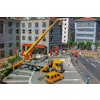
If there is anything we have learned over the years in the road paving industry, it’s that we need to increase the use of sustainable technology, while decreasing cost. The Michigan Department of Transportation (MDOT) has accepted that challenge and is using crumb rubber asphalt or ground tire rubber (GTR) on segments of a 14 mile stretch of road in Kent County.
Through the years, MDOT has explored the use of rubberized asphalt on their roads – from bumpy beginnings in the 1990s, to ongoing research and testing that is exploring the latest developments relevant to recycled tire rubber use in asphalt.
“Crumb rubber was used on this roadway with new specifications and the latest technology from the asphalt folks” says John Richard, MDOT Communication Spokesman. “It’s going to attract a lot of activity.”
The $2.33 million project was completed between June 10th - August 25th 2013.
[subhead] GTR - the future of road building?
GTR is made of recycled rubber material from items like old tires. Used tires are processed by separating the casings, fabric and steel. The extracted rubber then is ground to the consistency of ground coffee. Approximately 1,500 tires are used to pave one lane mile of highway – that could save a lot of space in landfills across the country.
The GTR is then mixed with regular asphalt, and the side by side comparison will show if it is more durable, cooler, smoother, sound resistant and easier to spread. The immediate advantage is going green by using tires from landfills, and is part of MDOTs green initiative, Richard adds
The Arizona Department of Transportation (ADOT) has been using GTR on their roads since the 1970s. “We received even more attention when a decision was made to add a thin layer — about an inch thick — on top of our concrete freeways in the Phoenix area starting last decade,” says Doug Nintzel, spokesman for the ADOT.
This decision was made as a part of ADOT’s Quiet Pavement Program. The three-year, $34 million project, will surface about 115 miles of Phoenix-area freeways with rubberized asphalt. ADOT is working toward a smoother ride for motorists and quieter neighborhoods for those who live adjacent to the roads. Noise readings have shown the rubberized asphalt generally reduces tire noise by an average of 4 decibels.
However, GTR is highly temperature sensitive. The ADOT website says the pavement surface needs to be between 85° F and 145° F for the material to adhere properly.
Richard with MDOT said this is the reason a majority of the project took place between 8 p.m. and 6 a.m. as temperatures were cooler and there was also less traffic for the paving contractor to compete with.
[subhead] Testing for perfection
Michigan Paving and Materials (MP&M) was the prime and paving contractor for the project. Using 20 employees from the paving crew for work operations and traffic control, they completed the paving work in just over 2 months due to a few nights of wet weather and the specifications of the GTR mix needed cooler temperatures.
MP&M chose the terminal method of blending for this job as no facilities in the area produce the product in Michigan. “The terminal method is where the GTR is added to the liquid asphalt and blended at the asphalt terminal, says Jason Van Patten from MP&M. The GTR came pre-blended from Seneca Petroleum in Ohio and shipped as any other liquid to MP&M’s asphalt plant in Grand Rapids for incorporation into the mix.
The GTR is being evaluated against other hot mix asphalt (HMA) pavements within the project limits. “The project has three segments constituting 11.3 miles of mill and resurface construction,” says Richard.
“Each segment has separate performance grade (PG) binders for the evaluation,” Richard adds. “The western segment (4.8 miles long) is our standard 5E3 mix with PG 64-22. The middle section (3.2 miles long) is a polymer mix of 5E3 with PG 70-22P. The east section (3.2 miles long) has the recycled tire rubber 5E3 with PG 70-22.”
MDOT will be evaluating performance characteristics/durability particularly with Michigan’s winter temperatures and freeze/thaw cycles. “GTR is the closest to a polymer mix in terms of placement and performance characteristics which is why the middle section has a polymer mix included for comparison,” says Richard. “Normally a polymer mix would not be utilized in the design for the traffic volumes experienced on this corridor; however, traffic volumes will likely remain relatively the same over the entire stretch and provide a good comparison in terms of wear and tear by traffic.”
“Polymer mixes are stronger, more expensive and go above the required standards. Using the RTR as opposed to the traditional polymer is better for the environment, and upon widespread use, should prove to be more cost effective. "If it performs well, of course we will use it again, and so will others.” Richard adds













![Fcp Racatac Chair 10893876[1]](https://img.forconstructionpros.com/mindful/acbm/workspaces/default/uploads/2025/10/fcp-racatac-chair-108938761.10l0At5WXv.png?ar=16%3A9&auto=format%2Ccompress&bg=fff&fill-color=fff&fit=fill&h=135&q=70&w=240)

